


 |
September 20, 2016: An Arts District Tour with Guy |
 |
August 18-21 & 25-28, 2016: Two Visits to San Antonio |
 |
Return to the Index for 2016 |
On September 6th, Prudence and Ron came up to Grapevine to stay with Nancy for a few days and celebrate her birthday. We were pleased to be included in the festivities, which included a visit to the "Le Nain" exhibit at the Kimbell Museum in Fort Worth. We also hosted the group for a visit to Klyde Warren Park in downtown Dallas.
Nancy's Birthday Dinner at Bob's Chophouse in Grapevine
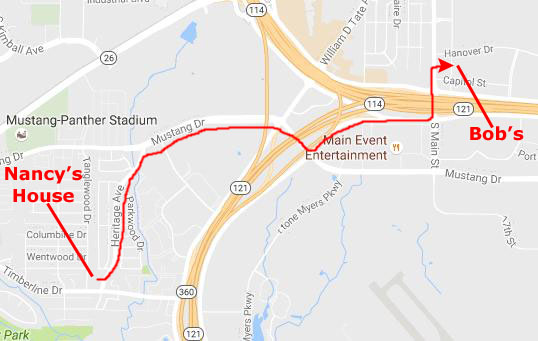 Where in the World is Bob's? |
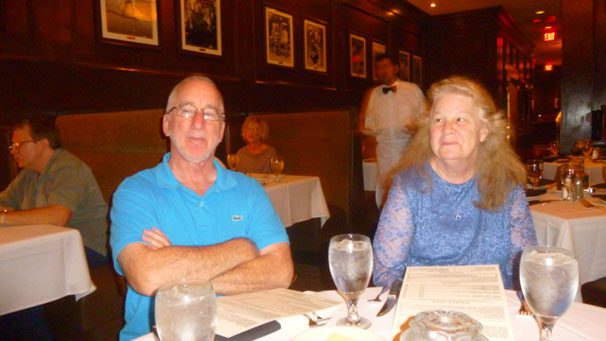 Karl and Nancy |
We always enjoy going to Bob's. Ron always has Prudence order for him and text him when his salad comes so he can head right over to the cigar area. Nancy and her sister always share something (as do Fred and I) and Karl usually gets a steak. The meals are always good, and they have a container of killer pickles on the table. Here are the other two pictures I took at Bob's this evening:
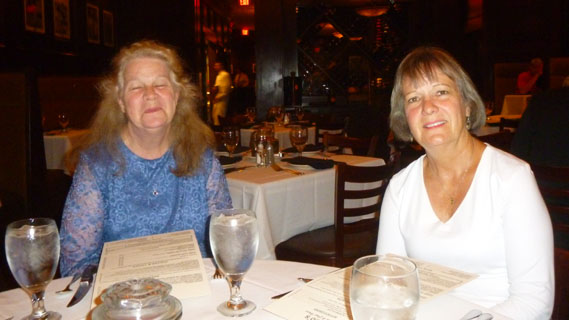 Nancy and Prudence |
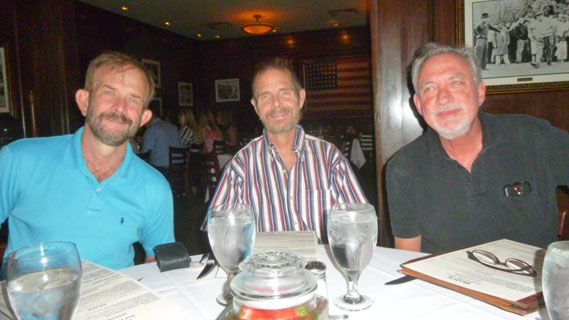 Fred, Myself, and Ron |
Lunch at the Modern Art Museum in Fort Worth
Getting to the Museum District in Fort Worth
|
The neat thing about this way of getting to Fort Worth is that Highway 121 dumps you right onto Belknap Street, which angles southwest across the north end of downtown Fort Worth, passing by a number of the oldest and most historic buildings in the city.
|
At this intersection, a left turn onto University (heading south) and then a right turn onto Darnell Street brings you right in front of The Modern (and you can see the Kimbell ahead of you less than a block away.
There are more than just these two museums in the Cultural District. There are two more museums- the Amon Carter Museum of American Art and the Museum of Science and Natural History. We are also just a couple of blocks from Will Rogers Arena and Casa Mañana Theatre.
|
After that, we will walk down the street to the Kimbell to go to a special exhibit on the art of the brothers Le Nain, which will be in the new Piano Pavillion. Admission to the Kimbell is always free, but this will be a special show, and so Fred and I will treat the group to admission to the event.
Originating as a city museum, rather than one donated by a wealthy patron, there is an admission charge for the Modern. (Like the Kimbell, the Amon Carter Museum of American Art and the Science Museum are also free- again except for some special shows).
The Modern Art Museum of Fort Worth: Museum and Cafe
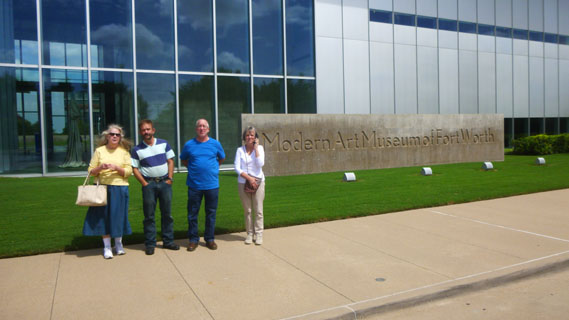 |
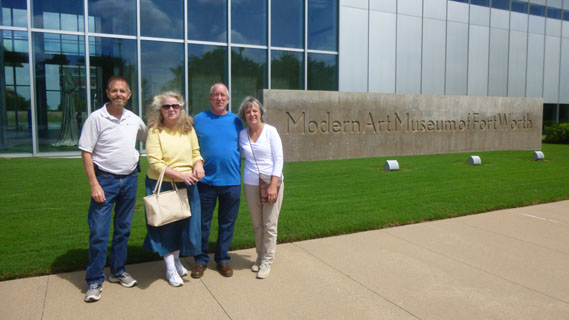 |
We didn't actually plan on going through the galleries here at the Modern today; our objective was the special show over at the Kimbell. But we did want to have lunch in the cafe here.
|
When you first come in to the huge lobby, the entrance desk is off to your left, and the auditorium and The Modern Cafe are off to your right. Directly in front of you are floor-to-ceiling glass windows. If you walk over and look out, you see a beautiful reflecting pool, with the glass wings of the galleries to your left, and the circular glass wall of The Modern Cafe off to your right.
The four of us had a nice lunch in the Cafe; the menu was quite varied and we all enjoyed our selections. Of course, I had my camera with me and before we started eating, I took a picture of the rest of our group.
|
He took a couple of them, and the best one is the one at right. I thanked him, and he returned to his table- but not before saying that he wished he'd always had someone to take pictures of he and his wife when they were hiking or on some other vacation. That comment stuck with me, and while I was waiting for our food to arrive, I thought I would go over and tell them that they might want to invest in a "selfie stick". I got into a bit of conversation with them; he was an engineer and his wife was a lawyer.
I gave them the address of my online photo album as they mentioned some of the places they'd been and these were the same as some of those where Fred and I have been. They seemed like very nice people.
When we were finished with lunch, we went back out to the street in front of The Modern, turned right, and walked the half block down to the Kimbell. At the corner, there was an interesting poster advertising one of the current special exhibits at the Modern Art Museum.
"The Brothers Le Nain": A Special Exhibit at the Kimbell
|
With the appointment in 1965 of Richard F. Brown, then director of the Los Angeles County Museum of Art, as the Museum’s first director, the Foundation began planning for the future museum and development of the collection, and developed a Statement of the future museum's purpose. In accordance with that policy, the Foundation acquires and retains works of so-called “definitive excellence”— works that may be said to define an artist or type regardless of medium, period, or school of origin. The aim of the Kimbell is not historical completeness but the acquisition of individual objects of “the highest possible aesthetic quality” as determined by condition, rarity, importance, suitability, and communicative powers. The rationale is that a single work of outstanding merit and significance is more effective as an educational tool than a larger number of representative examples.
Two aspects of the 1966 policy in particular would have the greatest impact on changing the Kimbell collection: an expansion of vision to encompass world history and a new focus on building through acquisition and refinement a small collection of key objects of surpassing quality. The Kimbell collection today consists of about 350 works that not only epitomize their periods and movements but also touch individual high points of aesthetic beauty and historical importance.
We entered the Kimbell through the lower-level main entrance; from there, dual staircases lead up to the main barrell-vaulted space. At the south end are the main exhibit halls, and at the north end the cafe and a sculpture garden. The gift shop area is in the middle of the space at the top of the stairs.
 I had Prudence, Nancy, Karl and Fred sit in front of the window that looks out to the sculpture garden. |
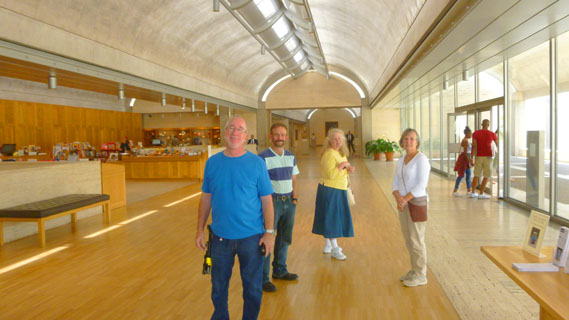 This view looks south through the Kimbell's main open area towards the galleries. |
The exhibit we had come to see ("The Brothers Le Nain: Painters of Seventeenth-Century France") was over in the new Piano Pavilion, which houses special exhibitions as well as much of the Kimbell's permanent collection of sculpture. To get there, we left the main building through the revolving door in the right-hand picture above and walked across the open lawn between the two buildings. As we did so, I took some pictures of the Kimbell's main building.
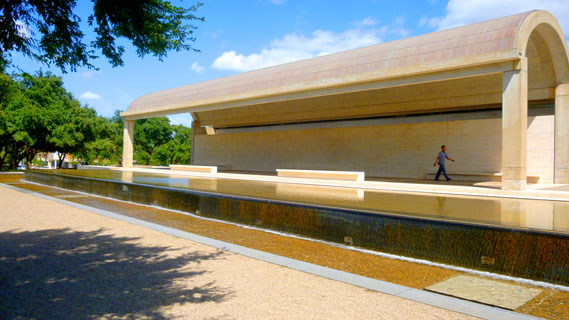 This view is of the outside of the north end of the building; there is an infinity pool and waterfall here. The cafe is inside the building beyond the barrell-vaulted portico. |
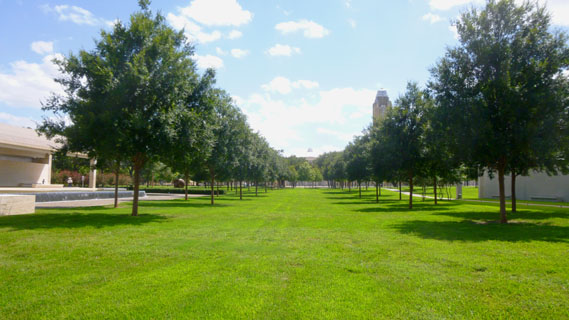 This view looks south across the lawn towards the Will Rogers Convention Center about three blocks away. There is another portico/infinity pool/waterfall at this end of the building as well. |
I like the waterfalls here at the Kimbell; the infinity pools must be perfectly level for the water to fall so uniformly all across the length of each pool. Below are a movie of the pool (left) and a picture that Fred took of me looking back towards the Kimbell main building (right):
|
(Mouseover Image Above for Video Controls) |
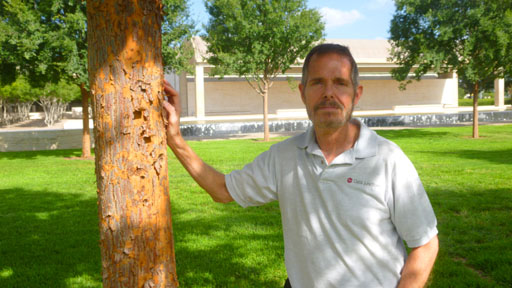 |
While I was walking over to the Piano Pavilion, I thought I would do another of my stitched-together panoramics. I should have walked along the lawn, rather than stand in once place; that way, I would have eliminated much of the "fish-eye" effect:
 |
I then went on over to the entrance to the Piano Pavilion to catch up with everyone else. This new Pavilion has not been open for perhaps five years now; Fred and I have been here twice to see special exhibits. “Close enough for a conversation, not too close and not too far away,” remarked architect Renzo Piano, when describing the distance from the Kimbell’s new Renzo Piano Pavilion to the Louis Kahn Building. Piano’s acknowledges Kahn’s museum building by way of its kindred height, emphasis on natural light, and use of concrete as a primary material. The positioning of the pavilion on the site focuses attention on the west facade of the Kahn Building, which Kahn considered to be the main entrance.
|
|
Fred and I got admissions to the exhibit for the group; sadly, photography was not allowed in this special exhibit. We did have an excellent guide, however, and it was her narrative and descriptions that made the exhibit come alive. The Brothers Le Nain: Painters of Seventeenth-Century France is the first major exhibition in the United States devoted to the Le Nain brothers- Antoine, Louis, and Mathieu- who were active in Paris during the 1630s and 1640s.
|
The Le Nain brothers have long been shrouded in mystery. Little is known of their lives, and the attribution of their paintings to the hands of the individual brothers has been hotly debated. The exhibition also described new research concerning the authorship, dating, and meaning of their works. It was accompanied by the results of a major study by the conservation departments of the Fine Arts Mueeums of San Francisco and the Kimbell Art Museum in cooperation with the Musee du Louvre.
We enjoyed the exhibit a great deal and spent the better part of a couple of hours going through it with our guide. When we came out, Prudence and Nancy wanted to look through the Pavilion store. While the girls were looking through the store, Fred and I wandered around the Piano Pavilion; we'd been here before and there are lots of pictures of the building on other photo album pages.
|
When we came outside again, I thought the light was just right for a good view of the Kimbell's first building- the Kahn Building (right).
Karl drove everyone back to Nancy's house; we'd actually brought Bob out for a play date with his sister Dora Tobisina, and we were curious to see how they'd gotten along (famously, as it turned out). Prudence was staying with her sister for a few days, so we asked them to come over to Dallas on Friday so we could take them to lunch and to the new Klyde Warren park.
Klyde Warren Park and the Dallas Arts District
|
Many years later in 2002, the idea resurfaced in the real estate community and in 2004, The Real Estate Council provided $1 million grant to fund feasibility studies and provide staff support during the incubator stage. Other donors came on board, leading to the formation of the Woodall Rodgers Park Foundation, the organization that led the project from design to completion. Construction on the deck began in October 2009 and the park celebrated its grand opening in October 2012.
The park deck is a feat of engineering and design. It had to be at street level yet preserve clearance for the highway below. An ingenious arrangement of more than 300 concrete beams and a large number of support members have created a solid deck for the park. They also created a series of gigantic "planter boxes," suspended over the freeway, that are large enough that small trees can be planted in them.
We began our picture-taking at the southwest corner of the park, and here are some of those pictures:
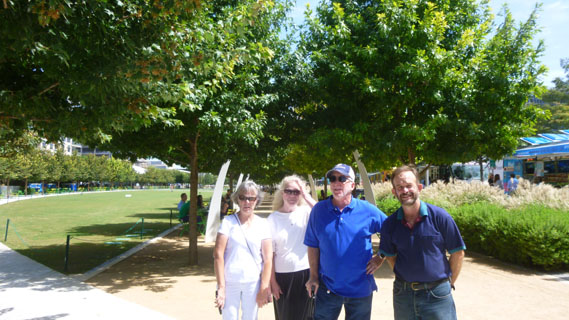 Here are Prudence, Nancy, Karl and Fred standing at the southwest corner of the park, and the view looks to the northeast along the long axis of the park. |
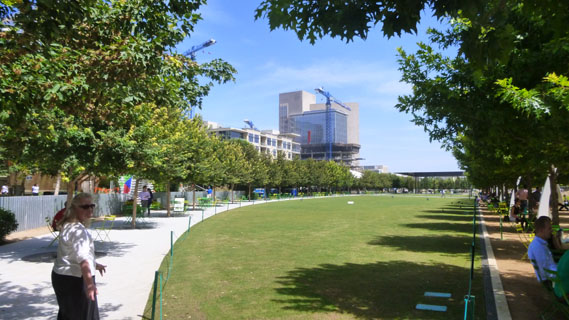 Here is a view of entire park, looking northeast with the Dallas Federal Reserve building in the far background. All of what you see is constructed on a deck over the eight-lane Woodall Rogers Freeway. |
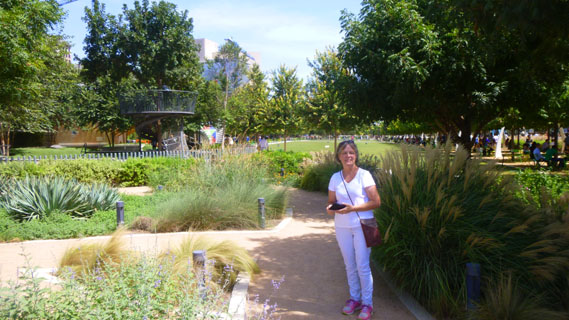 One of the attractions of the park is that it is adorned with many native Texas plants, and there is a small garden at the southwest end of the park with many of these. Here is Prudence in that garden, with the kids' playpark behind her. |
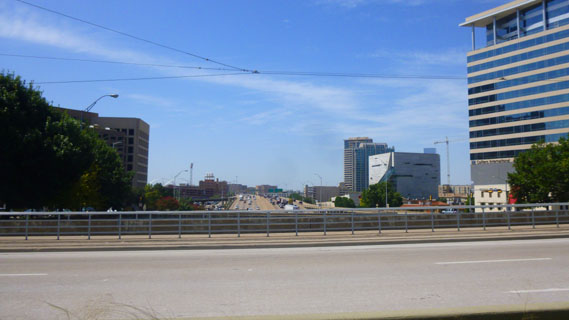 I walked out of the park for a moment to take this picture looking to the southwest. You can see that Woodall Rogers Freeway descends below grade and goes entirely underneath the park. The park deck used to be open (save for the cross streets) so all that space was wasted. |
From the Kids' play area, we walked northeast along the walkway, passing a reading and games area sponsored by The Dallas Morning News; the area has tables and chairs and racks containing newspapers and magazines and a selection of games like chess and checkers.
|
|
One of our purposes in coming down here today is to take Prudence, Nancy, and Karl to lunch, and we have chosen outdoor seating at Lark on the Park, just across the street from the park on its northwest side. We had a nice meal; our server and I took a couple of pictures worth including here:
|
|
We had a pleasant lunch at the restaurant, walked around some more of the northern end of the park for a while, and then headed back to the car- this time walking along the east side of the DMA.
|
The landscape designer created different “rooms” throughout the 5-acre park. The sustainable landscaping includes 37 native plant species and 322 trees, hiding an active freeway with a beautiful green area.
There are open lawns, rows of trees, a children's playground, a performance stage, an outdoor library, water features and areas for a restaurant and for a series of upscale food trucks that provide service all day long.
At left you can see some of these food trucks, which are parked in a marked area reserved for them on the southeast side of the park. I have never patronized one, but they must do well as there is a waiting list for permits to park one there. I've read that there are so many, that a rotating system is being devised to give more vendors an opportunity.
As we slowly walked the long two blocks along the side of the DMA (it was warm this afternoon) and then around by the Ross Avenue entrance to where our car was parked, I took a few pictures.
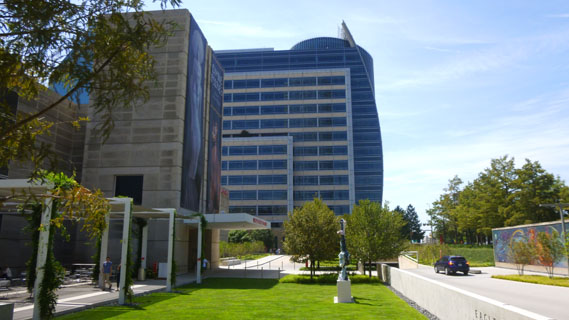 This view, taken from just across the street from the food trucks, looks southwest past the entrance to the DMA to the Bass Energy Building a block away. |
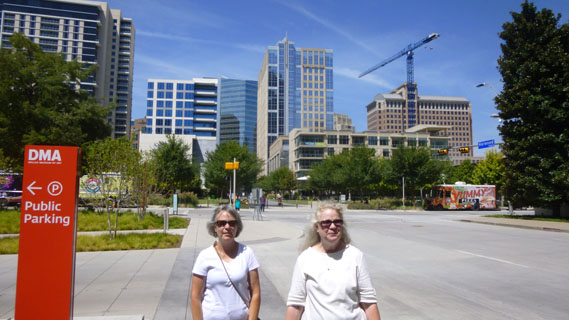 Looking back from the same point, here are Prudence and Nancy with Klyde Warren Park and Lark on the Park behind them. |
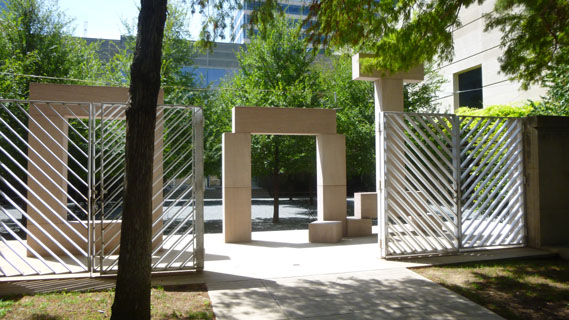 This is the entrance to one of the small outside gardens on the east side of the DMA. |
 Here are Prudence and Nancy at the east entrance to the DMA. |
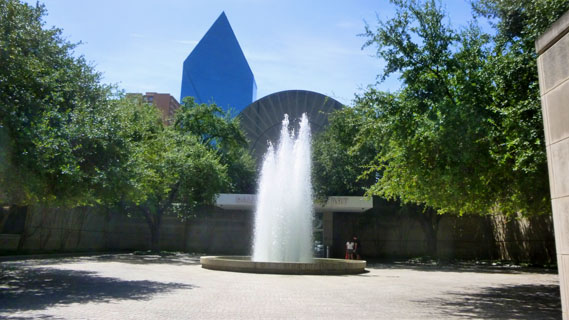 This is the fountain at the east entrance to the DMA. |
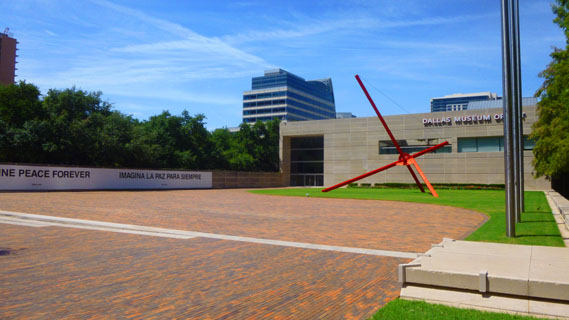 This is the Ross Avenue entrance to the DMA, and its signature sculpture. |
At the corner where the last picture was taken, I took one final picture of Nancy at the Arts District marker; the district runs from the DMA northeast between Ross Avenue and Woodall Rogers, and includes the DMA, the Nasher Sculpture Museum, the Trammell Crow Asian Art Collection, the Meyerson Symphony Center, the Winspear Opera House, the AT&T Performing Arts Center, the Wyly Theature, the Dallas City Performance Hall, and the Booker T. Washington High School for the Arts.
Fred and I enjoyed showing Prudence, Nancy and Karl the new park and a bit of the Arts District.
You can use the links below to continue to another photo album page.
 |
September 20, 2016: An Arts District Tour with Guy |
 |
August 18-21 & 25-28, 2016: Two Visits to San Antonio |
 |
Return to the Index for 2016 |